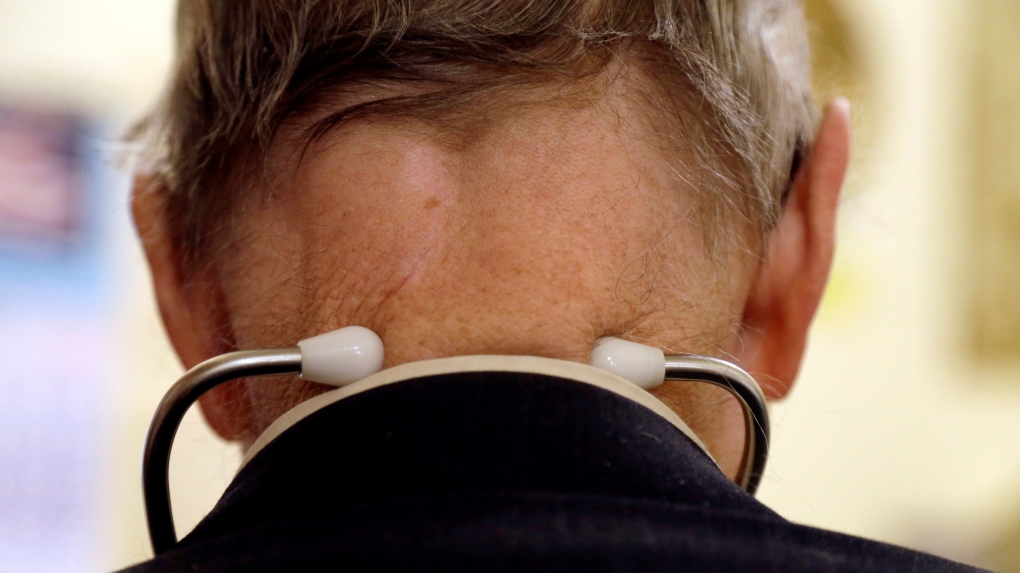'My family doctor just fired me': Ontario patients frustrated with de-rostering
Dozens of Ontarians are expressing frustration in the province’s health-care system after their family doctors either dropped them as patients or threatened to after they sought urgent care elsewhere.
Nearly 100 people contacted CTV News Toronto over several days in response to a callout for personal experiences with the process known as “de-rostering.”
Many said that they had no idea that they could be dropped as patients and only found out about it after they visited another clinic for care.
Ottawa resident Ashley Desrochers said that in mid-January she made the decision to visit an after-hours clinic for urgent care after her legs started to severely swell. Her family doctor agreed to see her, she said, but had no availabilities for about two months.
She decided to go to a walk-in facility associated with her primary care provider, and while there she saw her own family doctor – who promptly gave her an appointment a few days later.
However, she said that her doctor warned her that if she had seen any other doctor while at the other clinic, he would be charged.
“If I were to go to the clinic again, he would release me as a patient, even though this was the first time I had access the clinic for the year,” Desrochers said. “That took me aback. I know that doctors need to be paid for their time, and they can't afford to have their patients go somewhere else. But when we're in a situation where we need to see our doctor and we can't see our doctor, we have no other choice than to go somewhere else.”
Many of the people who contacted CTV News Toronto expressed concern over de-rostering threats, though the majority were not ultimately dropped as patients.
In one instance, an individual suffering from mental health challenges said she chose to book a virtual appointment for an assessment and prescription over a weekend. She said that at her next appointment with her family physician, she was informed that if she went to someone else for care, she could be de-rostered.
The parent of a 15-year-old wrote in to say that her child received care while away at a summer camp five hours away from where their family doctor’s office was located. She was removed from her family doctor’s patient list upon her return.
Jennie Carr from Mississauga told CTV News Toronto her doctor sent her a letter after she took her teenage son, who suffers from seasonal strep, to a walk-in clinic for antibiotics. She said she was unable to make an appointment for that day.
“I received an email from my doctor scolding me for taking my son to a walk-in clinic because they get billed when you take them to a walk-in clinic and out of respect for my relationship with my doctor, I should wait until he has availability and if it’s an emergency we should take him to an emergency room,” Carr said.
 Jennie Carr from Mississauga says she was threatened with de-rostering after taking her son to a walk-in clinic. (Provided)
Jennie Carr from Mississauga says she was threatened with de-rostering after taking her son to a walk-in clinic. (Provided)
Carr has since found a new primary care provider.
Many of the responses were from patients seeking care elsewhere out of either urgent need or convenience for minor ailments.
North York resident Edward Chan, 36, said that a couple of years ago he chose to see a doctor virtually to get orthotics, as he knew it could take a while to get an appointment with his primary care provider.
“It's a nightmare trying to book an appointment. And even when you get to the appointment, you're waiting a long, long time before you get to see him,” Chan told CTV News Toronto. “I figured something like this didn’t really need that much time.”
Within 20 minutes he had his prescription. But when he needed to book his annual physical with his family doctor, he was told by the receptionist that he had been de-rostered. Eventually he learned it was due to his decision to seek care elsewhere.
“I joked around with my friends and family and I told them, my family doctor just fired me,” Chan said. “How can this happen in Canada?”
Chan says he doesn’t blame his family doctor, noting he has seen his primary care provider for over 30 years. Rather he is angry at the system in place.
“We shouldn't need to go to them for the littlest things like sick notes and prescription,” he said. “The fact that the family doctors, they get punished for this, and then we get punished for doing that. It's ridiculous.”
Why does this happen?
Family doctors in Ontario are paid using a variety of systems. Some operate under a fee-for-service model, in which they are reimbursed under the Ontario Health Insurance Plan (OHIP) for every service they provide a patient. The other is an enrollment system, in which doctors are paid per patient, regardless of how many times they see them.
 A doctor wears a stethoscope around his neck as he tends to patients in his office in Illinois on Tuesday, Oct. 30, 2012. THE CANADIAN PRESS/AP, Jeff Roberson
A doctor wears a stethoscope around his neck as he tends to patients in his office in Illinois on Tuesday, Oct. 30, 2012. THE CANADIAN PRESS/AP, Jeff Roberson
However, under the enrolment or rostered system, every time that patient seeks care elsewhere, the family physician is deducted part of the available funding.
“It ranges anywhere from 50 to 100 per cent (of the fee),” Toronto Dr. Fred Freedman told CTV News Toronto.
Freedman says the rostered system is beneficial, as it allows doctors to provide care without worrying about the dollar amount attached. However, he added it also means the Ministry of Health deems it a “failure” if they can’t meet the 24/7 needs of a patient.
“We commit to providing all the internal practice services to everybody on our roster. But it does not prohibit people on our roster from going anywhere to get their primary care, and it's deemed a failure of our practice, of any roster practice, if a patient goes somewhere else,” he said.
“So we have to be there whenever they want care, but if they decide to go somewhere else, that's their business and we have to pay for it.”
According to the Ministry of Health, there were more than 5,800 family physicians enrolled in a Family Health Organization as of 2022.
Another 2,500 are part of a Family Health Group, 224 are part of a Family Health Network, and just over 1,600 family physicians work under the fee-for-service system.
“Patients enrolled with a family doctor should always seek treatment there first, however, should they require immediate care, and cannot access the family doctor, they can seek care in any primary care setting, such as a walk-in clinic,” a spokesperson for the Minister of Health said in a statement. “Should they need to visit a walk-in, patients are always encouraged to follow-up with the family doctor afterwards.”
“In certain circumstances, when a patient receives care from more than one health care provider, an enrolling physician may decide to de-enroll a patient, but can continue to provide services to the patient on a fee-for-service basis.”
The government says the deductions are from “a potential bonus payment that can be earned by the enrolling group.” The ministry says it does not impact the physician’s base pay.
The ministry says that bonuses and premiums account for 10 per cent of a physician’s compensation.
CTVNews.ca Top Stories

Prime Minister Trudeau meets Donald Trump at Mar-a-Lago
Prime Minister Justin Trudeau landed in West Palm Beach, Fla., on Friday evening to meet with U.S.-president elect Donald Trump at Mar-a-Lago, sources confirm to CTV News.
'Mayday! Mayday! Mayday!': Details emerge in Boeing 737 incident at Montreal airport
New details suggest that there were communication issues between the pilots of a charter flight and the control tower at Montreal's Mirabel airport when a Boeing 737 made an emergency landing on Wednesday.
Hit man offered $100,000 to kill Montreal crime reporter covering his trial
Political leaders and press freedom groups on Friday were left shell-shocked after Montreal news outlet La Presse revealed that a hit man had offered $100,000 to have one of its crime reporters assassinated.
Questrade lays off undisclosed number of employees
Questrade Financial Group Inc. says it has laid off an undisclosed number of employees to better fit its business strategy.
Cucumbers sold in Ontario, other provinces recalled over possible salmonella contamination
A U.S. company is recalling cucumbers sold in Ontario and other Canadian provinces due to possible salmonella contamination.
Billboard apologizes to Taylor Swift for video snafu
Billboard put together a video of some of Swift's achievements and used a clip from Kanye West's music video for the song 'Famous.'
Musk joins Trump and family for Thanksgiving at Mar-a-Lago
Elon Musk had a seat at the family table for Thanksgiving dinner at Mar-a-Lago, joining President-elect Donald Trump, Melania Trump and their 18-year-old son.
John Herdman resigns as head coach of Toronto FC
John Herdman, embroiled in the drone-spying scandal that has dogged Canada Soccer, has resigned as coach of Toronto FC.
Weekend weather: Parts of Canada could see up to 50 centimetres of snow, wind chills of -40
Winter is less than a month away, but parts of Canada are already projected to see winter-like weather.


































